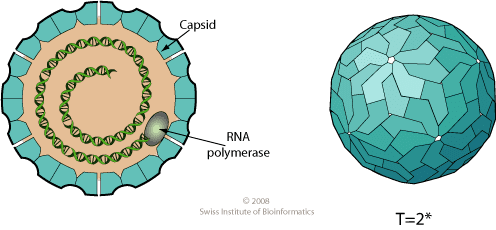Group Group III (dsRNA) | Rank Family | |
 | ||
Similar Partitiviridae, Chrysovirus, Cystovirus, Tetraviridae, Corticovirus | ||
Totiviridae is a family of viruses. Giardia lamblia, leishmania, trichomonas vaginalis, and fungi serve as natural hosts. There are currently 28 species in this family, divided among 5 genera.
Contents
Taxonomy
Group: dsRNA
Structure
Viruses in Totiviridae are non-enveloped, double-stranded RNA viruses with icosahedral geometries, and T=2 symmetry. The virion consists of a single capsid protein and is about 40 nanometers in diameter.
The genome is composed of a linear double-stranded RNA molecule of 4.6–6.7 kilobases. It contains 2 overlapping open reading frames (ORF)—gag and pol—which respectively encode the capsid protein and the RNA-dependent RNA polymerase. Some totiviruses contain a third small potential ORF.
Life Cycle
Viral replication is cytoplasmic. Replication follows the double-stranded RNA virus replication model. Double-stranded RNA virus transcription is the method of transcription. Translation takes place by -1 ribosomal frameshifting, +1 ribosomal frameshifting, viral initiation, and RNA termination-reinitiation. The virus exits the host cell by cell-to-cell movement. Giardia lamblia protozoa, leishmania protozoa, protozoan trichomonas vaginalis, and fungi serve as the natural host.
